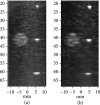Highly Integrated Multiplexing and Buffering Electronics for Large Aperture Ultrasonic Arrays
- PMID: 35928598
- PMCID: PMC9348545
- DOI: 10.34133/2022/9870386
Highly Integrated Multiplexing and Buffering Electronics for Large Aperture Ultrasonic Arrays
Erratum in
-
Erratum to "Highly Integrated Multiplexing and Buffering Electronics for Large Aperture Ultrasonic Arrays".BME Front. 2022 Sep 27;2022:9818934. doi: 10.34133/2022/9818934. eCollection 2022. BME Front. 2022. PMID: 37850159 Free PMC article.
Abstract
Large aperture ultrasonic arrays can be implemented by tiling together multiple pretested modules of high-density acoustic arrays with closely integrated multiplexing and buffering electronics to form a larger aperture with high yield. These modular arrays can be used to implement large 1.75D array apertures capable of focusing in elevation for uniform slice thickness along the axial direction which can improve image contrast. An important goal for large array tiling is obtaining high yield and sensitivity while reducing extraneous image artifacts. We have been developing tileable acoustic-electric modules for the implementation of large array apertures utilizing Application Specific Integrated Circuits (ASICs) implemented using 0.35 μ m high voltage (50 V) CMOS. Multiple generations of ASICs have been designed and tested. The ASICs were integrated with high-density transducer arrays for acoustic testing and imaging. The modules were further interfaced to a Verasonics Vantage imaging system and were used to image industry standard ultrasound phantoms. The first-generation modules comprise ASICs with both multiplexing and buffering electronics on-chip and have demonstrated a switching artifact which was visible in the images. A second-generation ASIC design incorporates low switching injection circuits which effectively mitigate the artifacts observed with the first-generation devices. Here, we present the architecture of the two ASIC designs and module types as well imaging results that demonstrate reduction in switching artifacts for the second-generation devices.
Conflict of interest statement
Conflicts of Interest R.W., Q.Z., D.N.S., and K.W.F. have patents and/or patent applications that include aspects of the research presented in this paper. The other authors declare no conflict of interest.
Figures

















References
-
- Hoskins P. R., Martin K., and Thrush A.. Diagnostic Ultrasound: Physics and Equipment, Cambridge University Press, 2010
-
- Shung K. K.Diagnostic Ultrasound: Imaging and Blood Flow Measurements, CRC Press, Second, 2015
-
- Otto C. M.The practice of clinical echocardiography, Elsevier Health Sciences, 2007
-
- Fernandez A. T., Gammelmark K. L., Dahl J. J., Keen C. G., Gauss R. C., and Trahey G. E., “Synthetic elevation beamforming and image acquisition capabilities using an 8 x 128 1.75D array,” IEEE Transactions on Ultrasonics, Ferroelectrics, and Frequency Control, vol. 50, no. 1, pp. 40–57, 2003 - PubMed
-
- Tamano S., Yamazaki M., Sano S., Hara K., Sakano J., and Miwa Y., “3D ultrasound imaging system using Fresnel ring array,” IEEE symposium on Ultrasonics, vol. 2, pp. 1310–1313, 2003
Grants and funding
LinkOut - more resources
Full Text Sources
Research Materials

